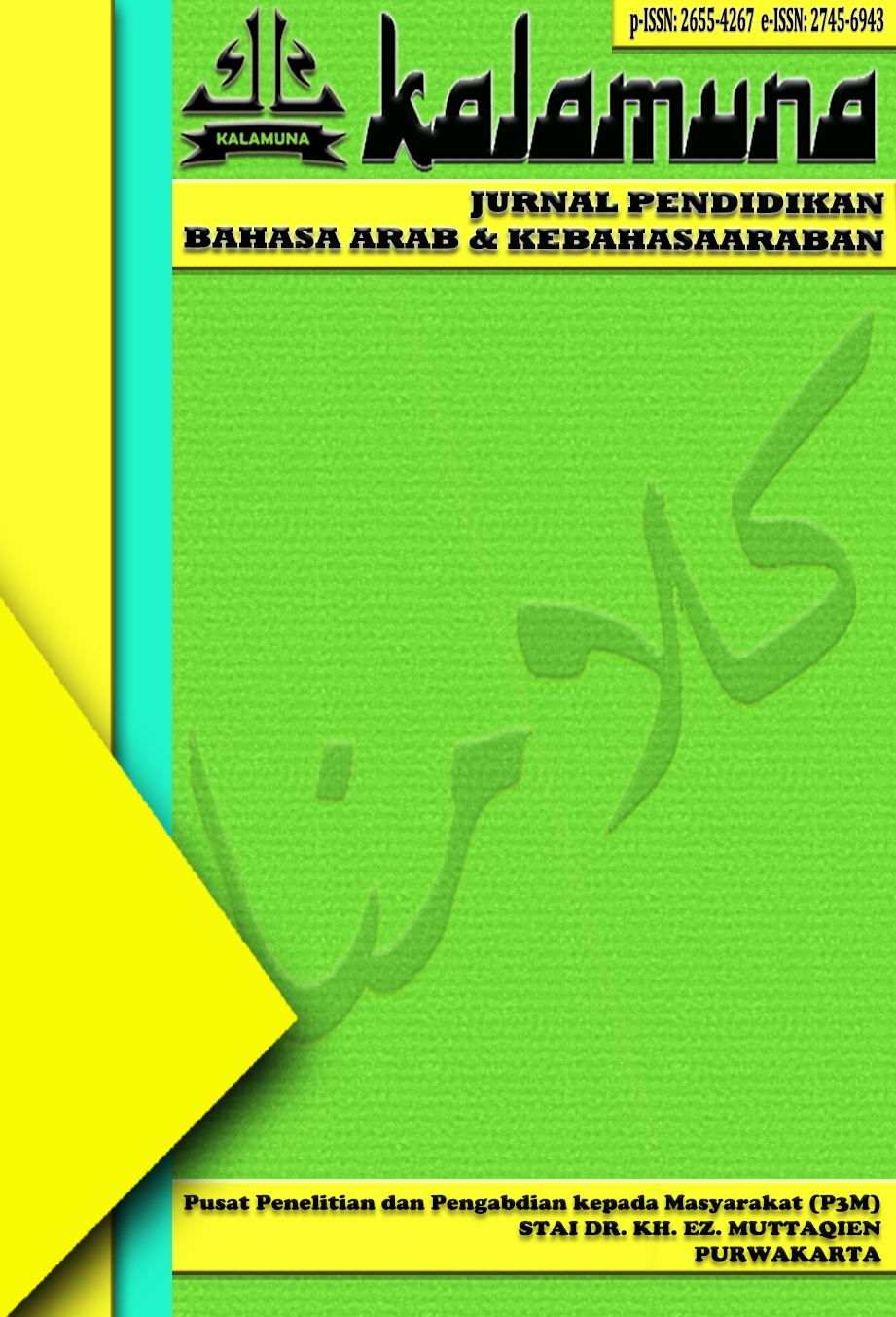Konsep Aritmetika pada Perubahan Kata Bahasa Arab
Keywords:
Arabic words, Arithmetic perspectives, word classification, verb users (fa'il)Abstract
This study aims to find out the changes in Arabic words in terms of arithmetic perspectives that occur either changing in word classification or only changing in terms of users (fa'il) of the verb. This research uses library research, the focus of the study is 29 wazan contained in the morphology of the Arabic language. So, the analysis is an elaboration of the arithmetic patterns contained in the wazan. The results of this study show that the derivation (tashrif ishtilahy) consists of additional letters that are at the beginning, in the middle and at the end of the word, the addition of letters is varied in number, some get an additional one letter, some get an additional two letters, and the addition of three letters, this addition makes a fairly significant change in meaning, although the meaning still has the same root. In the letter subtraction only three letters are reduced (illat letters). Meanwhile, in the multiplication process, there is one letter that is duplicated in the form of tasydid after previously the word was added to a certain number of letters. In the inflection process, the letter added is a letter that indicates the number of performers of the verb and the gender of the perpetrator, while in nouns the change is found in the plural of estimates where the change is influenced by a certain wazan.
References
Aini, N. (2018). Neologi Istilah Politik Dalam Bahasa Arab Modern Kajian Morfologi. Arabiyatuna : Jurnal Bahasa Arab, 2(2), 103. https://doi.org/10.29240/jba.v2i2.488
Carieska, V. A., & Husein, S. H. (2020). URGENSI MEMAHAMI MORFOLOGI SHOROF MENGGUNAKAN METODE TASRIF. Semnasbama, 4, 483–488.
Dharma, J., Zein, A., & Jaya, I. (2019). ARITHMETIC OPERATIONS IN THE QUR’ANIC CUES TO MATHEMATICS EDUCATION. Edu-Riligia, 3(4), 485–497.
Fajar, A. (2020). Tafsir al-Qur’Än Corak Sastrawi dan Teologis. Kalamuna: Jurnal Pendidikan Bahasa Arab Dan Kebahasaaraban, 1(1), 36–63. https://doi.org/https://doi.org/10.52593/klm.01.1.03
Hafidz, M. (2018). Memahami Balaghah Dengan Mudah. Journal TA’LIMUNA, 7(2), 129. https://doi.org/10.32478/talimuna.v7i2.187
Hakim, M. L., Kholisin, & Hanafi, Y. (2020). Proses Morfologis Wazan-Wazan Fiil Mazid Dan Maknanya Dalam Al-Quran Juz 28. Tarling: Journal of Language Education, 3(2), 201–228. https://doi.org/10.24090/tarling.v3i2.3532
Hidayah, N. (2022). Taá¹£mÄ«m Ta’lÄ«m mahÄrah Al-KitÄbah ‘Ala Ḍau’al-Madkhal al-BinÄÄ« li al-ṬÄlibah bi Qism Ta’lÄ«m al-Lugah al-Arabiyyah. INTERNATIONAL CONFERENCE ON ISLAM AND EDUCATION “Moderate Islamic Education for Sustainable Development in Plural Society,†1079–1093.
Julianti, Susilawati, & Dede Rizal Munir. (2022). Penggunaan Metode Dialog (Muhawaroh) dalam Keterampilan Berbicara Bahasa Arab Kelas VII di MTs Daarul Ma’arif Purwakarta. Kalamuna, 3(2), 196–212.
Kesuma, M., & Sari, R. P. (2020). Pengembangan Modul Sharaf Dengan Pendekatan Deduktif Di Pondok Modern Madinah Lampung. Studi Arab, 11(1), 27–36. https://doi.org/10.35891/sa.v11i1.1944
Muzakki, A. (2021). Reconstruction of Morphological ( ʻIlmu Sharf ) Learning Methods For Arabic Language and Literature Students Rekonstruksi Metode Pembelajaran Morfologi ( ` Ilmu Sharf ) Bagi Mahasiswa Jurusan Bahasa Dan Sastra Arab. 4(1), 1–16. https://doi.org/10.18860/ijazarabi.v4i1.9873
Najah, M. (2019). Penerapan Pembelajaran Shorof Bagi Pembelajar Tingkat Pemula Menggunakan Metode Pemerolehan Bahasa. Al MahÄra: Jurnal Pendidikan Bahasa Arab, 5(1), 117–140. https://doi.org/10.14421/ALMAHARA.2019.051-07
Nasiruddin. (2020). Metode Pembelajaran Qawâ’id (Nahwu-Sharaf) dengan Pendekatan Integrated System. EDULAB: Majalah Ilmiah Laboratorium Pendidikan, 4(2), 102–114. https://doi.org/10.14421/edulab.2019.42-06
Nasution, S., & Martua, M. (2021). KONTRIBUSI ANALISIS KONTRANSTIF MORFOLOFI BAHASA ARAB DAN BAHASA INDONESIA DALAM PEMBELAJARAN BAHASA ARAB UNTUK PENUTUR BAHASA INDONESIA. 147–161.
Ninis. (2013). Pengaruh Pemahaman Konsep Aritmetika Terhadap Kemampuan berfikir Aljabar Siswa (Studi Kasus pada Siswa Kelas VII SMP Negeri 1.
Raswan, Wahab, M. A., & Hakki, S. (2022). SIMPLIFIKASI MORFOLOGI ARAB ( SHARF ) DENGAN PENDEKATAN KONSTRUKTIVISME DAN ANALOGI. 7(1), 25–37.
Shobirin, M. S. (2020). Jamak Nomina Proses Morfologis Pembentukan Jamak Nomina Dalam Bahasa Arab. Journal of Educatio n and Management Studies and Management Studies, 3(1), 57–66.
Sukarani, N. M., & Bella, C. (2022). Sejarah Aritmatika : Manfaat Pembelajaran. Dunia Ilmu, 2(1), 1–8.
Sulaikho, S., & Mathoriyah, L. (2019). RESPON MAHASISWA TERHADAP BUKU AJAR MORFOLOGI. 4(2), 51–64.
Sulistiani, E., & Masrukan. (2016). Pentingnya Berpikir Kritis dalam Pembelajaran Matematika untuk Menghadapi Tantangan MEA. Seminar Nasional Matematika X Universitas Semarang, 605–612.
Wahyono, I. (2019). Strategi Kiai Dalam Mensukseskan Pembelajaran Nahwu Dan Shorof Di Pondok Pesantren Al-Bidayah Tegalbesar Kaliwates Jember [Kiai’s Strategy in Succeeding Nahwu and Shorof Learning at Al-Bidayah Islamic Boarding School Tegalbesar, Kaliwates Jember]. Tarbiyatuna : Kajian Pendidikan Islam, 3(2), 106.
Zuhriyah, L., Sholihuddin, A., & Thohir, M. (2018). Proses Afiksasi Morfologi Ism (Nomina) Dalam Bahasa Arab. Jurnal Pendidikan Bahasa Arab Dan KebahasaAraban, 5(2), 292–313. https://doi.org/10.15408/a.v5i2.8976













